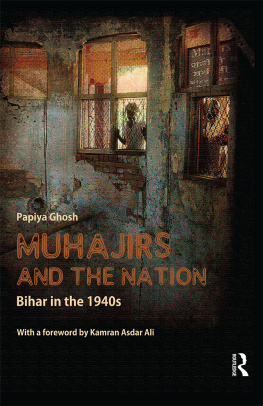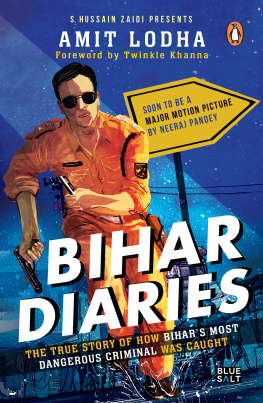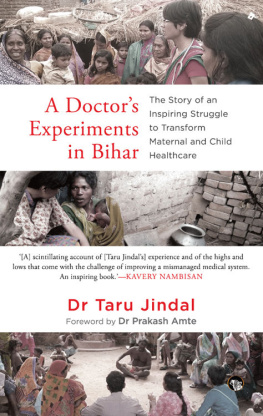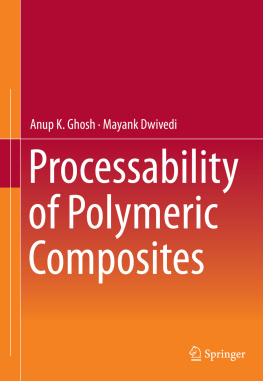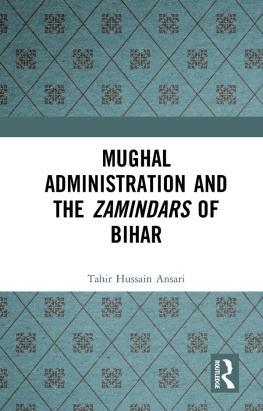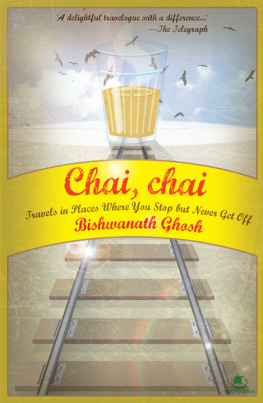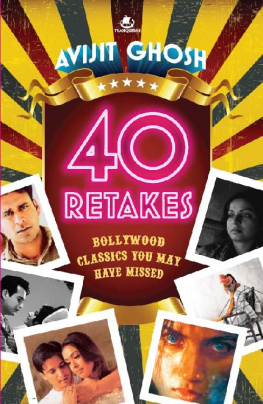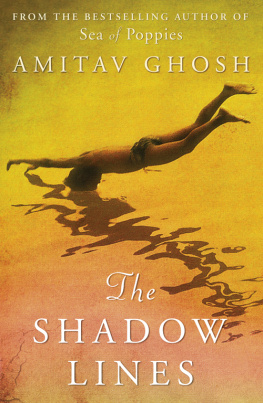First published 2010
by Routledge
912915 Tolstoy House, 1517 Tolstoy Marg, New Delhi 110 001
Simultaneously published in the UK
by Routledge
2 Park Square, Milton Park, Abingdon, OX14 4RN
Routledge is an imprint of the Taylor & Francis Group, an informa business
Transferred to Digital Printing 2010
2010 Purnujjal Papiya Ghosh Memorial Trust, New Delhi
Typeset by
Star Compugraphics Private Limited
D156, Second Floor
Sector 7, Noida 201 301
All rights reserved. No part of this book may be reproduced or utilised in any form or by any electronic, mechanical or other means, now known or hereafter invented, including photocopying and recording, or in any information storage and retrieval system without permission in writing from the publishers.
British Library Cataloguing-in-Publication Data
A catalogue record of this book is available from the British Library
ISBN: 978-0-415-54458-0
Watan thaa to azadi dhoondta thaa
Ab azad hoon to watan dhoondta hoon
(often recited by muhajirs)
When Ayesha had first migrated from Bihar to East Pakistan someone had asked her, Why are you going to East Pakistan?
At that time Ayesha, like millions of Ayeshas, had replied, Ask Rajjos father!
Twenty years later, she was migrating once again. This time someone asked her, Why are you going to West Pakistan?
Ayesha replied, Ask Nurul!
extract from Jalees (1994)
On the morning of 15 May 1954 riots broke out among workers at the Adamjee Jute Mills near Narayanganj, Dhaka (then East Pakistan). The violence subsided by mid-day, but left in its path almost 400 dead, including women and children, and scores injured. The clash was primarily between two groups of labourers, one Bengali and the other Bihari a generic term for migrants from India whether they came from Bihar or not. The immediate cause for the conflict was connected to the workplace politics within the mills. Yet, the Bengali peoples larger sense of deprivation of their cultural and civic rights and the presence of outsiders as competitors for scarce formal sector jobs may also have played a part in the onset of this violence.
The discussion on the riots at the Adamjee Jute Mills in 1954 is based on the reading of American Consul General to Dept. of State, Dacca Despatch no. 123, 22 May 1954, NND 842909 890d.062.
The episode has to be understood in light of how, by the mid-1950s, the promise of Muslim nationalism (that led to the creation of Pakistan in 1947) had been severely put to test by regional and nationalistic claims from Pakistans diverse ethnic groups. Foremost was the voice of its Bengali citizens, who, as the largest demographic group, claimed their fair share from the overtly centralising state in Karachi, 1,400 miles away from Dhaka. The violence also came in the wake of provincial elections in March of 1954 in East Pakistan that led to the routing of the Muslim League, the founding party of Pakistan that had dominated its politics since its inception. The formation of the provincial government by the United Front resulted in an upsurge of radical incidents in different parts of the province. By mid- to late-March there emerged labour disturbances in a match factory in Khulna, in the Chandragona Paper Mills and in the Adamjee Jute Mills in Dhaka. In all these, there were elements of anti-management agitation, yet they also manifested an exuberance over the victory against the Muslim League government that had ruled East Bengal till then. The labour strikes were further indicative of the latent ethnic tensions in the province that would in a matter of a decade-and-a-half become evident in the separatist movement, culminating in a brutal civil war and the creation of Bangladesh as a sovereign nation in 1971.
Clearly, Pakistans history in its post-colonial period has been one of contestation and conflict around questions of national self-determination of various ethnic groups, while the promised or imagined religious (Muslim) cohesiveness and national belonging has been difficult to achieve. Ironically, for some the 1954 violence was perhaps reminiscent of the Noakhali and Bihar riots of 1946. Not even a decade earlier this area was rife with communal violence and was the test case for the Muslim Leagues call for a separate Muslim homeland that led to the exodus of millions from their ancestral lands. Seventeen years after the unrest at the Jute Mills, Bangladeshs independence itself created another migratory cycle for the group of people whose history and diasporic journey became Papiya Ghoshs lifes work. No other scholar of contemporary South Asia has dedicated herself to unfold the various histories and trajectories of Bihari Muslims in the latter half of the twentieth century. It was during one of her research travels to the United States in the mid-1990s that I came in contact with her. My own autobiography became a way for us to connect. The Bihari ashrafs that she documents in her many writings may very well have been my own family that for generations had lived, prospered and buried their dead in various districts in Bihar. My mothers family, the more urban and educated, were from the Bihar Sharif area and her maternal uncle was Professor Abdul Bari, the radical Congress leader. My fathers family, having served their masters well, had over the years risen to become established zamindars in Gaya district and eagerly served the Raj while consolidating their feudal claims on the local population, Muslims and Hindus alike. So, a range of political affiliations, allegiances and alliances that existed among Bihari Muslims which Papiya documents in this text were present in my own family. What was also present was a keen sense of being unique and above other Muslim groups, castes and lineages. In a way the creation of Pakistan and the subsequent migration of some of my relatives (including my father as a young man, but not his parents or his sister who later joined the Communist Party of India [CPI] in Calcutta) sustained this arrogance of ashraf exceptionalism. Absent in our childhood stories were references to those Muslims who were not considered our social equals and belonged to lower castes. Marriage that institution par excellence for reproducing privilege among this group of Bihari Muslims until recently even in Pakistan was limited to those within the larger kin and lineage or, as my maternal grandmother, the keeper of family honour, would constantly say, haddi mein (literally, in the same bone)! However, the new land made this division difficult to sustain and invariably some who were underprivileged and subordinate would surface as social equals and threaten the symbolic stature of ashraf exclusivity. The newness of the country also meant a certain democratisation where age-old customs and taboos could be broken and social station could be contested. Those who migrated at times did indeed come from more urban milieux than the local population and high and low alike reinvented themselves to take advantage of the distribution of evacuee properties and other riches left behind by those who were forced to leave their own ancestral lands. The world had changed and the process produced acute anxiety in households such as mine, especially when daughters were given in marriage to others for financial security rather than social continuity. Papiyas text sensitively tackles this topic of ashraf and


